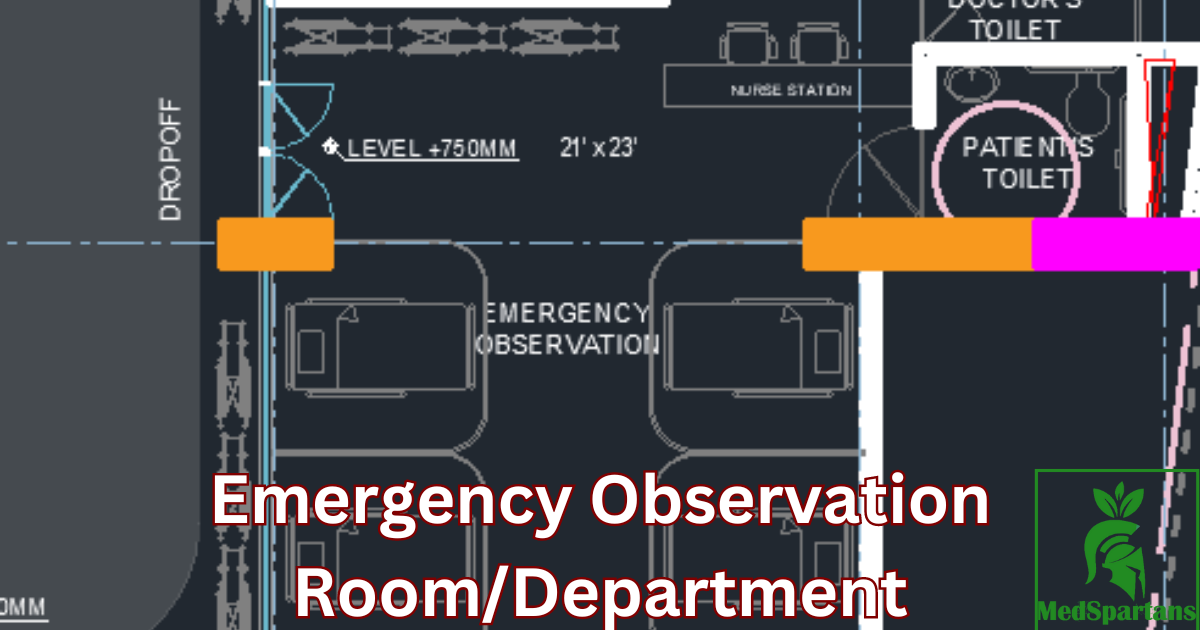Hospital Emergency rooms can be stressful, long waits, and confusing layouts. However, they’re supposed to be places where patients receive fast, efficient care. Outdated layouts and cramped spaces can actually create long waits and frustration for everyone involved.
This chaos can worsen patient anxiety and hinder communication with medical staff. Modern ER design prioritizes efficiency and a calming environment, leading to a smoother experience for everyone.
Today, let’s explore the key design parameters for a hospital emergency department or room. We’ve already covered the entire room design in a separate piece, complete with an AutoCAD image. You can find that information below:
MedSpartans offers the best strategic plan for General or any other hospital’s Emergency Department or Rooms. Make the best healthcare for everyone.

Why Are Emergency Rooms Designed The Way They Are
Emergency rooms (ERs) serve as the critical entry point for patients requiring urgent medical attention. But why are emergency rooms designed the way they are?
Well, their design is a product of meticulous planning, aimed at maximizing efficiency, ensuring patient safety, and providing comprehensive care under pressing circumstances. The primary goal of an ER is to deliver immediate and competent treatment to patients. This includes handling a spectrum of emergencies such as injuries, poisoning, myocardial infractions, and accidents.
The swift and efficient response facilitated by well-designed ERs can significantly impact patient outcomes, reducing the severity and duration of illnesses.
Strategic Location and Accessibility Of Hospital ERs
ERs are strategically located on the first floor, typically at the front of the hospital, with distinct entries to ensure easy and quick access. This location allows for seamless integration with other crucial departments like radiology and laboratories, enabling prompt diagnostic testing. Effective signage is vital in this setting.
Multilingual, illuminated signboards direct patients and visitors clearly, reducing confusion and delays in treatment.
Hospital Emergency Room’s Thoughtful Space and Layout
The size and layout of an ER are influenced by various factors, including the hospital’s location, the types of emergencies typically encountered, and academic activities. Key considerations include:
- Patient Demographics: Hospitals in industrial zones might encounter more trauma cases, while those in residential areas may see a higher incidence of cardiac and respiratory emergencies.
- Operational Data: Analysis of patient flow, disease patterns, and admission rates informs space allocation to ensure critical services function efficiently.
Key Functional Areas
To support optimal operations, ERs are segmented into several essential areas:
- Entrance Lobby: This includes a separate ambulance landing bay with a protective porch, designed to facilitate swift patient transfer regardless of weather conditions.
- Reception and Waiting Areas: These zones are crucial for managing patient intake and providing a calm environment for waiting relatives. Facilities like telephones, public address systems, and mobile charging points are essential.
- Treatment Zones: These encompass triage areas, resuscitation rooms, minor and major operating suites, and observation wards, ensuring that all emergency scenarios are adequately addressed.
Infection Control and Safety
Infection control is a top priority in ER design. Measures include dedicated decontamination areas near entrances, airlocks, and air curtains to minimize contamination risks. Handwashing stations, sanitizer dispensers, and PPE dispensing stations (e.g., for face masks and shoe covers) are strategically placed to maintain hygiene standards.
Comprehensive Support Services
ERs are supported by robust ancillary services to ensure 24/7 operational readiness:
- Ambulance Control: Includes dedicated parking, washing areas, and equipment storage, managed by a transport officer.
- Staff Facilities: Restrooms and relaxation areas for ambulance drivers and on-call medical staff are essential for maintaining a high level of readiness and performance.
How To Design General Hospital Emergency Room: Key Considerations
Designing an effective hospital emergency room (ER) is crucial for providing immediate and high-quality care to patients in critical conditions. Several key considerations must be taken into account to ensure the efficiency, safety, and functionality of the ER.
Here are the primary factors to consider:
- Location and Accessibility:
- The ER should be located on the ground floor, with a separate, clearly marked entrance.
- It should be easily identifiable using illuminated signboards, with proper directions displayed at the hospital entrance and within the hospital compound.
- The entrance should be near other critical departments like radiology and laboratories for quick diagnostic support.
- Signage and Wayfinding:
- Effective signage is crucial for guiding patients and visitors, especially in stressful situations.
- Signboards should display directions to all rooms within the ER, as well as facilities like toilets and drinking water.
- Multilingual signage, including the local language, should be used to cater to diverse populations.
- Signage for fire exits and escape routes must be prominently displayed.
- Size and Space Allocation:
- The overall size of the ER should be based on the expected volume and type of emergencies.
- Space must be allocated for stretchers, trolleys, and wheelchairs to ensure smooth patient movement.
- Separate areas should be provided for minor and major operation theaters, triage, observation wards, and disaster handling.
- Entrance Design:
- The ER should have two sets of doors: one for entrance and another for exit, ideally automated with sensors for ease of use.
- An airlock space between external and internal areas should be provided to minimize contamination and maintain air quality.
- Waiting Areas:
- A designated waiting area should be available for attendants, equipped with basic facilities such as telephones, toilets, and drinking water.
- Social distancing measures should be incorporated to ensure safety during outbreaks of contagious diseases.
- Mobile charging points and public address systems should be included to facilitate communication and convenience.
- Infection Control:
- The ER must have measures in place to prevent cross-infection, including handwash stations and hand sanitizer dispensers at the entrance.
- A decontamination area near the entrance should be provided for patients exposed to chemical, biological, or radiological hazards.
- Screening areas with isolated cabins should be used to identify and manage infectious patients promptly.
- Ambulance Services:
- A landing bay for ambulances, preferably with a protective porch, should be located near the ER entrance.
- Separate parking and cleaning areas for ambulances should be provided to ensure they are always ready for use.
- Facilities for ambulance drivers, including restrooms and relaxation areas, should be available near the ER.
- Technology and Equipment:
- The use of automated gates and barriers can enhance security and accessibility.
- Sensor-operated doors and air curtains can improve infection control and maintain internal climate conditions.
- Advanced screening and diagnostic equipment should be easily accessible within the ER to facilitate rapid diagnosis and treatment.
- Support Facilities:
- Adequate space for staff accommodation, including duty rooms for doctors and nurses, should be planned to ensure staff are readily available.
- Storage areas for medical and legal records, clean and dirty utilities, and disaster response equipment should be included.
- Equipment Need:
- Emergency Room equipment includes defibrillators, ventilators, ECG machines, ultrasound devices, suction machines, IV infusion pumps, crash carts, patient monitors, trauma stretchers, surgical instruments, and oxygen supply systems.
- Consult with a lisenced Biomedical Engineer to know what you need. You can also contact us. We offer the best equipment options for your Healtcare Needs. Contact Us for a free consulation.
Designing a hospital emergency room requires careful planning and consideration of various factors to ensure it meets the needs of patients, staff, and visitors effectively.
How to design an effective emergency room

Designing an effective emergency room involves several crucial steps to ensure that it is functional, efficient, and capable of handling various emergencies. Here are the steps:
1. Needs Assessment and Planning
- Evaluate Patient Volume: Assess the expected number of patients and the types of emergencies most frequently encountered.
- Stakeholder Consultation: Engage with medical staff, administrators, and architects to understand requirements and limitations.
- Compliance: Ensure the design meets all local regulations and standards.
2. Location and Accessibility
- Ground Floor Placement: Position the emergency room (ER) on the ground floor for easy access. (8.36 sq. mtr for each bed. Now do the calculation)
- Separate Entrance: Designate a separate, clearly marked entrance for the ER.
- Signage: Install clear, multilingual signage with proper directions.
3. Layout and Space Allocation
- Entrance and Lobby:
- Separate entrance lobby to avoid congestion.
- Dedicated landing bay for ambulances with a covered porch.
- Waiting Areas:
- Designate waiting areas for attendants with basic facilities like toilets, drinking water, and phone access.
- Maintain social distancing and limit the number of attendants per patient.
- Screening and Triage:
- Include isolated screening areas with negative pressure and UV sterilization.
- Provide a triage area close to the entrance for initial patient assessment.
4. Functional Zones
- Triage and Resuscitation: Ensure immediate access to triage and resuscitation rooms from the ambulance bay.
- Examination and Treatment Rooms: Allocate rooms for various procedures such as ECG, X-ray, plaster, and minor operations.
- Observation and Recovery: Design observation wards and post-operative recovery areas.
- Utilities and Support:
- Clean and dirty utility rooms.
- Staff duty rooms and rest areas.
5. Infection Control
- Air Quality Management: Implement airlocks, air curtains, and HEPA filters to control airflow and minimize contamination.
- Handwash and Sanitizer Stations: Place these at strategic points, especially near entrances and exits.
- Decontamination Area: Include a shower area for chemical or biological contamination cases.
6. Safety and Security
- Fire Safety: Ensure fire exits, alarms, and escape routes are well marked and accessible.
- Security: Install surveillance cameras and employ security personnel to monitor the ER.
7. Ambulance Services
- Parking and Access: Provide ample parking and clear access routes for ambulances.
- Equipment Storage: Allocate space for storing ambulance equipment and supplies.
- Driver Facilities: Include restrooms and relaxation areas for ambulance drivers.
8. Patient Comfort and Privacy
- Bed Capacity: Design wards with 10 to 30 beds, ensuring at least 8.36 sq. mtr per bed for comfort and privacy.
- Privacy Measures: Use curtains or partitions to provide privacy during treatment.
9. Technology Integration
- Automated Systems: Use automated doors, electronic medical records, and patient tracking systems.
- Communication Systems: Ensure robust communication systems for coordination with other departments.
10. Future-Proofing
- Scalability: Design with flexibility to expand or modify spaces as needs evolve.
- Durability: Use durable materials that can withstand heavy use and frequent cleaning.
By following these steps, an emergency room can be designed to handle patient needs effectively while ensuring safety, efficiency, and comfort.
Specifications For A Modern Emergency Room In Hospitals
Here’s all the specifications to design the perfect Emergency Room/Department in any hospital. Just follow them, and you will be all good to make the best Emergency Department in any hospital.
1. Function: Urgent diagnostic and therapeutic care for various patient categories.
2. Location: Ground floor, in front of the hospital, with a separate entry.
3. Signage: Multilingual, illuminated, clear directional signs, including special provisions for visually impaired and emergency exits.
4. Size Factors:
- Area: Depends on the volume and scope of services.
- Factors: Type of patients, academic activities, data analysis (patient numbers, stay duration, admission rates, etc.), space for equipment and facilities.
5. Required Areas:
- Entrance Lobby
- Trolley Park
- General Waiting
- Public Utilities
- Reception/Enquiry/Registration
- Procedure Rooms
- Plaster Room
- Utility Rooms (Clean and Dirty)
- ECG Room
- Medico-Legal Specimen Room
- Portable X-ray Room
- Disaster Storage Room
- Triage and Resuscitation
- Examination Cubicles
- Duty Rooms (EMO, Nurses, Doctors)
- Minor and Major Operating Suites
- Pre- and Post-Operative Rooms
- Sterilization and Clean Storage
- Toilets and Change Rooms for Staff and Doctors
6. Entrance Specs:
- Main Gate: Rustproof, automated options, free car parking, dedicated ambulance space, no humps.
- Entrance Doors: Separate for entry and exit, at least 2438 mm wide, automation and airlock features.
- Lobby: Separate from main entrance, with ambulance landing bay and porch.
7. Screening and Decontamination:
- Screening Areas: Isolated cabins for infection control.
- Decontamination: Near entrance, possibly tiled shower area.
8. Waiting Area:
- Attendants: One per patient, waiting area with basic facilities (telephones, toilets, drinking water, mobile charging).
9. Ambulance Control:
- Landing Bay: Under porch, clear traffic pattern.
- Parking: Covered or shed, cleaning facilities.
- Equipment Store: Controlled by Transport Officer.
- Driver Facilities: Restroom with toilet.
- Transport Office: Near or in the emergency department.
- Air Ambulance: Helipad if feasible and permitted by Aviation Authorities.
10. Ward Capacity:
- Beds: 10 to 30 beds per ward.
- Per Bed Area: Not less than 8.36 sq. mtr per bed.
What could be added or changed to make an emergency room more successful?
Things that could be added or changed to make an Emergency Room more successful are:
1. Clear Signage and Navigation: Guide patients effortlessly from entry to treatment with clear, easy-to-follow signs.
2. Enhanced Technology Integration: Utilize advanced technologies like AI triage systems for faster, more accurate patient assessments.
3. Comfortable Patient Spaces: Design soothing environments with private screening areas and family-friendly waiting rooms.
4. Team Collaboration: Foster teamwork between emergency staff and specialists for coordinated, efficient care.
5. Ongoing Staff Training: Empower your team with regular training in patient care and crisis management.
Note: Implementing these strategies can significantly enhance the efficiency, comfort, and overall experience for both patients and staff in your emergency room.
Frequently Asked Questions
How To Increase Patient Satisfaction In The Emergency Department?
To increase patient satisfaction in the Emergency Department, prioritize empathy and clear communication. Keep wait times transparent, offer amenities in waiting areas, and ensure a clean, efficient environment. Train staff to be patient and understanding, and address concerns promptly. By focusing on patient experience, you can turn a stressful visit into a positive one.
How To Improve Flow In The Emergency Department?
To improve ED flow, focus on three key areas: triage, staffing, and throughput. Streamline patient assessment, ensure adequate staff during peak hours, and expedite discharge processes to optimize patient flow.
What Are The Largest Challenges Of An Emergency Room?
Some of the biggest challenges emergency departments face include efficiently handling overcrowding, ensuring patient safety with limited resources, and effectively treating a wide range of patients with diverse needs.
What Makes A Good Emergency Room?
A good ER prioritizes quick, effective care. We need a skilled staff, advanced equipment, and clear layouts for efficient treatment. It should also be designed to minimize wait times and provide a calm environment for patients and families.
Conclusion
This article is your guide to designing an emergency department that prioritizes patient care. We’ve covered everything from the welcoming entrance to essential rooms for treatment.
By following these tips, you can create a space that puts patients first, keeps staff efficient, and minimizes the spread of infection.
Remember: Always check local building codes before you build! Emergency department design is constantly improving, so be ready to adapt as new needs arise.



